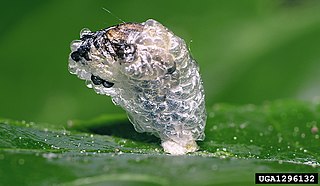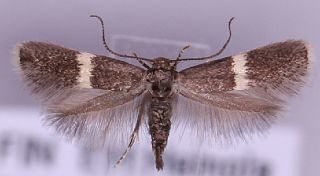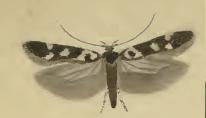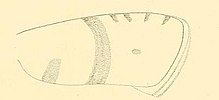Atralata is a genus of moths of the family Crambidae. It contains only one species, Atralata albofascialis, which is found in most of Europe, except Ireland, Great Britain, Norway, Finland, Lithuania and Greece.

Coleophora kuehnella is a moth of the family Coleophoridae. It was first described by Johann Goeze in 1783 and is found in Asia and Europe.
Coleophora congeriella is a moth of the family Coleophoridae. It is found from the Czech Republic and Slovakia to the Iberian Peninsula, Italy and Greece and from France to Bulgaria.

Elachista dispilella is a moth of the family Elachistidae. It is found from Fennoscandia to the Pyrenees and Italy and from France to Romania.

Elachista cingillella is a moth of the family Elachistidae found in Europe.

Caryocolum vicinella is a moth of the family Gelechiidae. It is found in most of Europe, eastwards to the southern Ural.

Heliozela hammoniella is a moth of the Heliozelidae family. It is found in Ireland, Great Britain, the Netherlands, France, Germany, Austria, the Czech Republic, Poland, Romania, Lithuania, Latvia, Fennoscandia, and Russia.

Argyresthia fundella is a moth of the family Yponomeutidae. It is found in most of Europe, except Ireland, Great Britain, the Iberian Peninsula, Finland, the Baltic region, Slovenia, Hungary and Greece.
Acrolepiopsis tauricella is a moth of the family Acrolepiidae. It is found Italy, Switzerland, Hungary and Ukraine.
Acrolepiopsis vesperella is a moth of the family Acrolepiidae. It is found in Germany, France, Spain, Portugal, Italy, Croatia, Serbia and Montenegro, Greece and on the Canary Islands. The larvae have a pale yellowish green body and head. They can be found in March.
Digitivalva eglanteriella is a moth of the family Acrolepiidae. It is found in France, Spain and Portugal and on Corsica and Crete.
Digitivalva perlepidella is a moth of the family Acrolepiidae. It is found in Great Britain, the Netherlands, France, Germany, Switzerland, Austria, Poland, the Czech Republic, Slovakia, Hungary, Croatia, Romania and Bulgaria.

Digitivalva reticulella is a moth of the family Acrolepiidae found in most of Europe, except Ireland, Great Britain, the Netherlands, France, Portugal, Slovenia, much of the Balkan Peninsula, and Lithuania.

Digitivalva valeriella is a moth of the family Acrolepiidae. It is found in Sweden, Denmark, Germany, France, Austria, Hungary, Romania, Slovakia, Poland, Lithuania, Latvia and Russia.
Digitivalva granitella is a moth of the family Acrolepiidae. It is found in most of Continental Europe, except Fennoscandia, the Netherlands, Portugal, the Baltic region, the western part of the Balkan Peninsula and Ukraine.
Digitivalva occidentella is a moth of the family Acrolepiidae. It is found in France, Spain, Italy, Croatia, Romania and on Crete. It has also been recorded from Turkey.

Digitivalva pulicariae is a moth of the family Acrolepiidae. It is found in most of Europe, except Portugal, Fennoscandia, the Baltic region and Poland.
Digitivalva solidaginis is a moth of the family Acrolepiidae. It is found in France, Spain and Russia.

Ochsenheimeria vacculella, the cereal stem moth, is a moth of the family Ypsolophidae. It is found in most of Europe, except Ireland, Norway, Portugal, Italy and most of the Balkan Peninsula. The species was accidentally introduced into parts of the United States.

Caryocolum kroesmanniella is a moth of the family Gelechiidae. It is found from Fennoscandia to the Pyrenees, Alps and Romania and from Great Britain to southern Russia. The habitat consists of open woodland.










